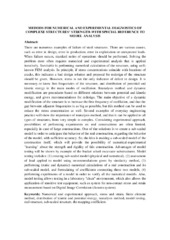Приказ основних података о документу
Methods for numerical and experimental diagnostics of complex structures’ strength with special reference to model analysis
| dc.creator | Petrović, Ana | |
| dc.date.accessioned | 2023-03-13T14:23:03Z | |
| dc.date.available | 2023-03-13T14:23:03Z | |
| dc.date.issued | 2020 | |
| dc.identifier.uri | https://machinery.mas.bg.ac.rs/handle/123456789/6011 | |
| dc.description.abstract | There are numerous examples of failure of steel structures. There are various causes, such as error in design, error in production, error in exploitation or unexpected loads. When failure occurs, standard series of operations should be performed. Solving the problem most often requires numerical and experimental analysis that is applied iteratively. Inevitable is performing numerical calculation of the structure, using wellknown FEM analysis. In principle, if stress concentrations coincide with locations of cracks, this indicates a bad design solution and proposal for redesign of the structure should be given. However, stress is not the only indicator of defect in design. It is necessary to know free frequencies of the structure, and distribution of potential and kinetic energy in the main modes of oscillation. Reanalysis method and dynamic modification are procedures based on different relations between potential and kinetic energy, and gives recommendations for redesign. The main objective of a dynamic modification of the structure is to increase the first frequency of oscillation, and that the gap between adjacent frequencies is as big as possible, but this method can be used to reduce the stress concentration as well. Several examples of everyday engineering practice will show the importance of reanalysis method, and that it can be applied to all types of structures, from very simple to complex. Considering experimental approach, possibilities of performing experiments on real constructions are often limited, especially in case of large constructions. One of the solutions is to create a sub-scaled model in order to anticipate the behavior of the real construction, regarding the behavior of the model, with sufficient accuracy. So, the idea is making a sub-scaled model of the construction itself, which will provide the possibility of numerical-experimental "learning" about the strength and rigidity of this construction. Advantages of model testing will be shown by example of the bucket wheel excavator substructures. Model testing includes: (1) creating sub-scaled model (physical and numerical), (2) assessment of load applied to model using recommendations given by similarity method, (3) performing (static and dynamic) numerical calculations of a real construction and its sub-scaled model, and formulating of coefficients connecting these two models, (4) performing experiments of a model in order to verify all the numerical models. Also, model testing allows testing in a laboratory "clean" environment, which also allows the application of sensitive test equipment, such as system for non-contact stress and strain measurement based on Digital Image Correlation (Aramis system). | sr |
| dc.language.iso | en | sr |
| dc.relation | info:eu-repo/grantAgreement/MESTD/Technological Development (TD or TR)/35040/RS// | sr |
| dc.rights | openAccess | sr |
| dc.rights.uri | https://creativecommons.org/licenses/by/4.0/ | |
| dc.source | Seminar Mechanics of machines and mechanisms- Models and Mathematical Methods, Mathematical Institute of SASA | sr |
| dc.subject | Numerical and experimental approach | sr |
| dc.subject | stress and strain | sr |
| dc.subject | finite element method | sr |
| dc.subject | distribution of kinetic and potential energy | sr |
| dc.subject | reanalysis method | sr |
| dc.subject | model testing | sr |
| dc.subject | real structure | sr |
| dc.subject | sub-scaled structure | sr |
| dc.subject | the mapping coefficient | sr |
| dc.title | Methods for numerical and experimental diagnostics of complex structures’ strength with special reference to model analysis | sr |
| dc.type | conferenceObject | sr |
| dc.rights.license | BY | sr |
| dc.citation.rank | M33 | |
| dc.identifier.fulltext | http://machinery.mas.bg.ac.rs/bitstream/id/14881/bitstream_14881.pdf | |
| dc.identifier.rcub | https://hdl.handle.net/21.15107/rcub_machinery_6011 | |
| dc.type.version | publishedVersion | sr |


